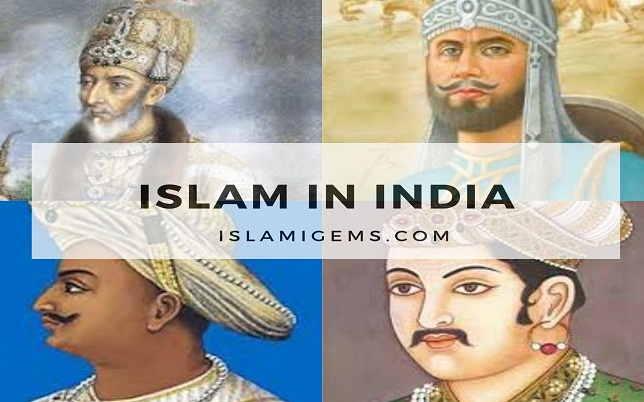When the Muslims had first set their feet on the Indian soil, they found here the ancient sciences and philosophy and an abundance of food and raw materials but, culturally India had lapsed into isolation from the civilized World for a long time. The mighty mountains on the north and the sea on the other three sides had prevented it from having a regular intercourse with the world that lay beyond its frontiers.
The last foreign invader to visit India before the Muslims was Alexander the Great. During the period between coming of Alexander and arrival of Muslims India had remained severely cut off from the outside world. There had been no exchange of knowledge with the foreign countries. No new ideas and fresh cultural impetus had reached it from abroad, nor had it been able to send out anything from its own ancient fund of wisdom.
Contents
Coming of Muslims to India
Islam came to India even before Muslim Rulers
Arab traders were in contact with India even before the arrival of Prophet Muhammad. Traders would regularly visit the west coast of India for trading goods such as spices, gold, and African goods.
Naturally, as the Arabs began to accept Islam, they carried their new religion to the India. Through continued trade between Muslims of Arabia and Indians, Islam continued to spread in coastal Indian towns and cities, both through immigration and conversion.
Coming of Muslim Saints and Preachers to India
Sometimes Muslims came to India supremely unconcerned with worldly aims and ambitions and were guided solely by the lofty sentiments of religious service. They brought with them the Islamic message of equity and social justice in order to show to men thirsting for light and freedom in a dark and narrow world the way to break their shackles and avail themselves of the priceless bounties of nature that were lying scattered over God’s wide earth.
The best instances of these dedicated, high-souled preachers are offered by the lives of the devoted servants of Islam under whose benign shadow thousands of oppressed members of the Indian society not only found shelter but also began to live as their own beloved kinsmen. The names of Hazrat Ali Hujweri, Khwaja Moinuddin Ajmeri and Syed Ali bin Shahab Hamadani Kashmiri are good representatives of this holy order of men.
Arrival of Muslim Rulers and Conquerors to India
Sometimes Muslims came as warriors and conquerors and deep-hearted rulers such as Mahmud Ghaznavi, Mohammad Ghori and Zahiruddin Babar. These men of courage and ambition laid the foundations of a magnificent empire that continued to prosper for hundreds of years and carried the India to glorious heights of progress and prosperity.
Social and Political conditions of India before Arrival of Muslims
The spectacle India presented was not different from other countries before the advent of Islam. Isolated from the rest of the world, the country was cut off by the sea in the south and east and the great chain of Himalayas in the North-West. The world had only a hazy idea of the land and its inhabitants. It was considered to be an extensive and fertile land, irrigated by innumerable rivers, great and small, whose people were devoted to philosophic ideals of Vedanta, practiced penance and self-mortification and delved into the problems of mathematics and astrology.
Cultural Stagnation of India
India had preserved its culture and social structure without any noticeable change for more than a thousand years with the result that stagnation and decay had set in almost in every field of life. Its artisans and entrepreneurs were not engaged, like those in the adjoining lands, in introducing new stratum in the old and static Indian culture, arts and literature, nor were there any visible signs of change in the development of its resources, mode of agriculture, commerce and industry or other fields of creative endeavour.2
The world had been able to peep into this closed land only occasionally through the windows opened by an ambitious conqueror like Alexander or a traveler like Alberuni. 1
Emperor Babar’s Description of India (Tuzuk-i-Babri)
In order to appreciate adequately the extent and value of Muslim influence on the Indian culture it is necessary to obtain some idea of the picture India presented before the arrival of Islam and the Muslims. Fortunately Babar has left behind a vivid description of cultural decadence that was evident on all sides and this makes the task of judging the worth and merit of Muslim contribution easy.
However it may be borne in mind that Muslims had begun their development activities in India quite a long time before the coming of the Mughals.
Tuzuk-i-Babri contains a vivid description of India and it cannot be better described than in his own words:
“Hindustan is a country of few charms. Its people have no good looks; of social intercourse, paying and receiving of visits there is none; of genius and capacity none; of manners none; in handicraft and work there is no form or symmetry, method or quality; there are no good horses, no good dogs, no grapes, no muskmelons or first-rate fruits, no ice or cold water, no good bread or cooked food in the bazaars, no hot-baths, no colleges, no candles, torches or candle sticks…”
“In the place of the candle, they use the divat (A crude sort of lamp made of clay, wood or iron in which mustard oil is generally burnt). It rests on three legs: a small iron piece resembling the snout of a lamp is fixed to the top end of one leg and a weak wick to that of another; the hollowed rind of a gourd is held in the right hand from which a thin stream of oil is poured through a narrow hole. Even in case of Rajas and Maharajas, the attendants stand holding the clumsy divat in their hands when they are in need of a light in the night.”
“Except their large rivers and their standing-waters which flow in ravines or hollows, there are no running waters in their gardens or residences. Their residences have no charm, air, regularity or symmetry.” (Memoirs of Babur, pp. 518-520)
The buildings lack beauty, symmetry, ventilation and neatness.
Commonly, the people walk barefooted with a narrow slip tied round the loins.
Women wear a dress consisting of one piece of cloth, half of which is wrapped round the legs while the other half is thrown over the head.”
Jawaharlal Nehru on India Before Muslims
Commenting on Babar’s observations on the cultural insolvency and backwardness of India, Jawaharlal Nehru has said in his famous book, The Discovery of India:
“…..…..his account tells us of the cultural poverty that had descended on North India. Partly this was due to Timur’s destruction, partly due to the exodus of many learned men and artists and noted craftsmen to the South. But this was due also to the drying up of the creative genius of the Indian people.
Babar says that there was no lack of skilled workers and artisans, but there was no ingenuity or skill in mechanical invention.”1
Features of Muslim Rule in India
Permanent Settlement and Spirit of Service
Whether the Muslims came to India as religious preachers or rulers, Muslims always treated India as their home. Their belief was that the earth belonged to God and He gave it in the supervision and keeping of whom He pleased. Muslims considered themselves to be the Divinely appointed trustees of His land and servants of His people. “Every country is our country for it is the country of our Lord” was their motto.
Muslim Rule vs British Rule in India
The Muslims unfailingly regarded India as their own country of permanent residence from which they could never turn their eyes away. Muslims gave to India their best mental, physical and spiritual resources, their finest natural abilities and talents in its service, thinking that the contribution they would make to its development and prosperity would ultimately be to their own advantage, for was not their future linked inseparably with it?
The attitude of Muslim settlers towards India was radically different from that of the British and other foreign Imperialistic Powers that came to hold sway over the land, or parts of it, at a later stage of its history. The object of the Western imperialists in India was simply to make hay while the sun shone. They treated India like a cow which had come into their hands for a few days, and were eager to milk it as thoroughly as they could. The devotion with which the Muslims strove for the advancement and prosperity of India can be understood only in this context.
Starting of Age of India’s Contact with the Outside World
It was at a time like this that the Muslims made their debut on the Indian stage. They were, in those days, the most advanced community in the East. Muslims brought with them to India a new, practical and highly rationalistic religion, mature knowledge, a progressive culture and an evolved civilization which included within it all that was best in the cultural stock of many nations. It represented a synthesis of the natural wholesomeness of the Arab disposition, the dainty refinement of the Iranians and the rugged simplicity of the Turks.
Muslims gave Concept of Divine Unity to India
The most valuable of these gifts was the sovereign and unalloyed Islamic concept of Divinity, which, at one stroke, dispensed with all intermediaries between man and the Maker in respect of prayer and supplication.
There is absolutely no place in the Islamic creed for beliefs like Polytheism, incarnation of God and ‘the merging of man in the Almighty and becoming one with Him.’
Islam declares, plainly and once for all, the Sovereignty and Absolute Oneness of the Divine Being— One and Everlasting—Who beget not nor is He begotten, and nor does He take partners in the discharge of the functions of Divinity.
The creation, the sustenance, the management and the ownership of the universe lie in Allah’s hands alone. It was but natural for a belief like this to make a powerful impact on the Indian mind as it had been out of touch with pure monotheistic doctrine for hundreds of years.
Prof. K. M. Panikkar says:
“One thing is clear. Islam had a profound effect on Hinduism during this period. Medieval theism is in some ways a reply to the attack of Islam and the doctrines of medieval teachers by whatever names their gods are known are essentially theistic. It is the one supreme God that is the object of the devotee’s adoration and it is to His grace that we are asked to look for redemption”.1
1. Panikkar, K. M.- A Survey of Indian History (1947), p. 163
Muslim Rule in India-Based on Equality and Brotherhood
In India a most remarkable social change was brought about by the Islamic notion of human equality and brotherhood. Some of salient features of Muslim rule were:
- No division of society into permanent classes
- No such community as the untouchables among the Muslims.
- Their belief was that no one was born unclean into the world
- The belief that no one was predetermined to be ignorant
- No one was debarred from acquisition of knowledge by the very fact of his birth in a certain class
- No trade or occupation was reserved for a particular section of humanity.
- Muslims fraternized freely with each other at all levels, the rich strove with the poor in the pursuit of learning and there was freedom of profession for all.
The idea of brotherhood was for the Indian mind and society a novel experience and a call to renewed thinking which did a lot of good to the country. The bonds of the then existing class-ridden society were relaxed to a considerable extent and there was witnessed a widespread recoil from the excessive rigidity of the caste-system.
The advent of Islam acted as a challenge to social reformers in other fields also. Pandit Jawaharlal Nehru has offered the following comments on the uplifting influence exerted by Islam and Muslims on the Indian social structure.
“The impact of the invaders from the north-west and of Islam on India had been considerable. It had pointed out and shone up the abuses that had crept into Hindu society—the petrification of caste, untouchability, exclusiveness carried to fantastic lengths. The idea of the brotherhood of Islam and the theoretical equality of its adherents made a powerful appeal especially to those in the Hindu fold who were denied any semblance of equal treatment”2
To quote another writer of repute;
“Islam’s democratic challenge has perhaps never been equaled by any other religious or social system. Its advent on the Indian scene was marked by a profound stirring of consciousness. It modified the basis of Hindu social structure throughout northern India.”3
2. Jawaharlal Nehru: The Discovery of India (1946) p. 225
3. Humayun Kabir: The Indian Heritage (1955). p. 133
Muslim Rulers against Barbaric Hindu Customs & Women Oppression
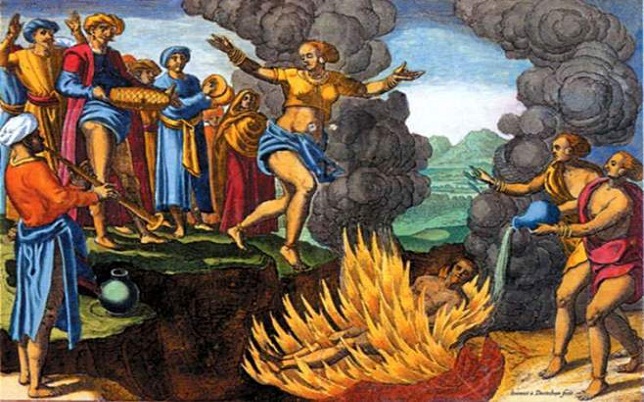
When Muslims came to India they gave proper recognition to the dignity of women of India and their rights as respectable members of the family and life-partners of men. The huge significance of the rights bestowed by Islam on the softer sex in a country where the practice of barbarous custom of Sati in which widows of noble families used to immolate themselves on the funeral pyres of their husbands since in the eyes of society, as well as in their own eyes, they forfeited the right to live with the death of their husbands, does not stand in need of an elaboration.
We are reproducing the lines from Burnier’s travel accounts to show that for instance what infinite pains did the Muslims took for the suppression of the custom of Sati from the earliest days of their rule.
“…………….the number of victims is less now than formerly; the Muslims, by whom the country is governed, doing all in their power to suppress the barbarous custom.”
“They do not, indeed, forbid it by a positive law, because it is a part of their policy to leave the idolatrous population which is so much more numerous than their own in the free exercise of its religion; but the practice is checked by indirect means.”
“No woman can sacrifice herself without permission from the governor of the province in which she resides, and he never grants it until he shall have ascertained that she is not to be turned aside from her purpose; to accomplish this desirable end the governor reasons with the widow and makes her enticing promises; after which, if these methods fail, he sometimes sends her among his women, that the effect of their remonstrances may be tried.”
“Notwithstanding these obstacles, the number of self-immolations is still very considerable, particularly in the territories of the Rajas, where no Muslim governors are appointed.”4
4. Francois Burnier: Travels in the Mogul Empire (1891), pp. 306-7
Introduction of Modern branches of Learning in India by Muslims
Muslims brought with them several modern branches of learning to India, One of the most important of which was history. Before the arrival of Muslims the writing of history was almost an unknown art in India, there being hardly anything to speak of in the line save religious treatises and a few epics like the Ramayana and Mahabharata.
Muslims produced a whole library of historical works that could compare favorably in authenticity and comprehensiveness with the endeavors made in this branch in any other country.
A glance through Maulana Syed Abdul Hai’s monumental book in Arabic, Es-Saqafal-ul-Islamia-Fil-Hind5 (Islamic Culture in India), will indicate what tremendous efforts were made by Muslims for the compilation of the history of India.
To quote Dr. Gustave le Bon :
“There does not exist a history of ancient India. Their books contain no historical data whatever, except for a few religious books in which historical information is buried under a heap of parables and folk-lore, and their buildings and other monuments also do nothing to fill the void for the oldest among them do not go beyond the third century B. C.
To discover facts about India of the ancient times is as difficult a task as tile discovery of the island of Atlantis, which, according to Plato, was destroyed due to the changes of the earth.”6
The writer, after admitting that the epics, Ramayana and Mahabharata, do shed some light on the conditions obtaining during those days, goes on to add that
“The historical phase of India began with the Muslim invasion. Muslims were India’s first historians.”6
5. The book has recently been published by the Arabic Academy, Damascus, Syria.
6. Gustave le Bon : Les Civilisalions de L’Indi (Urdu Translation by Syed Ali Bilgrami) Book III, p. 146
New Techniques in Literature by Muslims
Liberality of the mind, originality of thought and new techniques of poetry and literature were taught to the Indians by Muslims. A new angle of vision and a new horizon of thought could not be possible without intellectual and literary integration.
To the credit of Muslims also goes the birth of Urdu language which is a most beautiful living, growing and expanding language and became the medium of intercourse among people of the various parts of the country and an excellent vehicle of literary expression.
Muslims Revolutionized Indian Culture
The impact of Muslims in India is most prominent in the sphere of culture, social manners and general mode of living. The Muslims revolutionized the pattern of life in India and gave it a new form which was entirely different from what was known here formerly, just as the design of life in modern Europe is totally dissimilar to what prevailed there in the Middle Ages.
Reforms by Akbar and Sher Shah
Cloth-weaving factories were, also, established during the reign of Akbar. The great Mughal emperor, further, introduced many valuable agrarian reforms appertaining to the measurement of land, and the assessment and collection of land revenue.
The improvements made by Sher Shah and Akbar in the field of finance, especially in coinage and currency, had not been heard of in India before. Sher Shah had a unique gift for legislation and administrative organisation. In fact, it was his example which Akbar followed later.
Cleaner and Better Mode of Living
Over and above all this, the Muslims acquainted the original inhabitants of India with a cleaner and better mode of living. They taught them the refinements and luxuries of taste and of food and drink. They taught them the principles of hygiene and sanitation, the advantage of building airy houses and the use of cups and other vessels of food. Till then the Indians used to take their meals, even at large feasts, from leaves of trees, a custom which is still prevalent at some places.
The Muslims, in brief, brought about a big change in Indian social customs, living habits, domestic comforts and home- decoration. They ushered in a new style in architecture which, in the delicacy of its design, grace, symmetry and dignity, was distinguished from what traditionally obtained here.
The Taj Mahal offers a classical instance of the new Mohammedan architecture. In the words of Pandit Nehru from his book The Discovery of India:
“The coming of Islam and of a considerable number of people from outside with different ways of living and thought affected these beliefs and structure. A foreign conquest, with all its evils, has one advantage: it widens the mental horizon of the people and compels them to look out of their shells. They realize that the world is a much bigger and a more variegated place than they had imagined.
So the Afghan conquest had affected India and many changes had taken place. Even more so the Mughals, who were far more cultured and advanced in the ways of living than the Afghans, brought changes to India. In particular, they introduced the refinements for which Iran was famous.”
The same view was expressed by Dr. Pattabhi Sitaramayya in his Presidential Address to the Fifty-fifth Session of the Congress held at Jaipur in 1948. He said:
“Muslims had Enriched our culture, strengthened our administration, and brought near distant parts of the country………..It (the Muslim Period) touched deeply the social life and the literature of the land.”
Development of Fruit by Muslim Rulers of India

When Mughals came to India they saw that even though the soil was fertile but, few fruits were found in India and those too were of a poor quality. Most of them were grown wild. People did not take enough interest in the development of horticulture.
The Mughals, on the other hand, were possessed of a refined taste and there was a great abundance of fruit in their native land. Fruit-cultivation, accordingly made rapid progress in India with coming of Mughals. Details of it can be found in the famous memoirs of Emperors Babar and Jahangir—Tuzuk-i-Babari and Tuzuk-i-Jahangiri respectively.
The Mughals developed several new and delicious varieties of fruits by making extensive experiments in grafting. The mango is a well-known Indian fruit but, before the arrival of the Mughals, only one variety of mangoes, the seed-variety (Tukhmi) was in existence. It was the Mughals who developed the beautiful, luscious grafted mangoes. This step, in course of time, led to the introduction of numerous varieties of the fruit.
Development of Agriculture, Trade and Industry
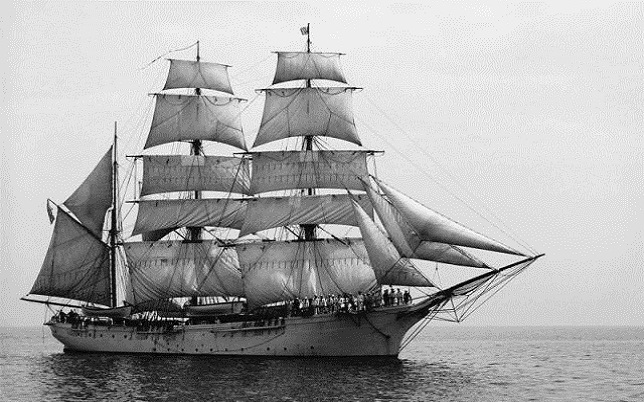
The same was the case with textile. Before coming of Muslims dresses in India were generally made from rough, coarse, cloth. A number of textile factories were set up in Gujarat by Sultan Mahmud Shah, better known as Mahmud Baigrah (d. 1511), where cloth weaving, dyeing, printing and design-laying were undertaken.
Sultan Mahmud Shah also established industrial centers for stone and ivory carving and paper-making. Gifted as he was with an advanced, constructive mind, the Sultan had succeeded in arousing a rare enthusiasm for progress in trade, industry and agriculture among his subjects.
Maulana Syed Abdul Hai says:
‘‘Among the outstanding works of the Sultan for the development of the country were included the construction of mosques and schools and the planting of fruit-bearing trees and orchards. He aroused the people magnificently for these tasks.
He also built wells and canals for irrigation. Skilled artisans and craftsmen came to him from Iran and Turkestan and set up their crafts and industries in his kingdom.
Due to the ceaseless efforts of Sultan Mahmud for the welfare of his people, Gujarat had become a rich, fertile stretch of greenery with flourishing gardens, dense groves and delicious fruit as well as an important trading center which exported cloth to foreign lands.”7
7. Nuzhatul Khawatir, Vol 4, p 345
Muslims brought Unani System of Medicine to India
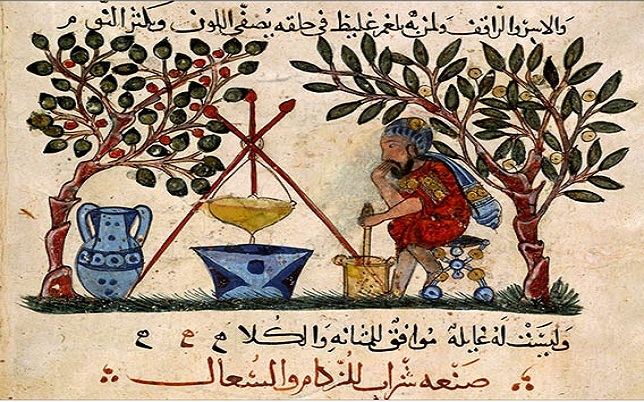
The Muslims brought to India a new system of medicine, the Unani system which, before the dawn of modern medicine, was universally recognized as the most advanced and scientific system for the treatment of diseases.
During their hey-days, the countries of Iraq, Iran and Turkestan were the most important centers of the Unani system of medicine in the world, and it was there that its greatest exponents and practitioners were born during the medieval age.
After the establishment of Muslim power in India, and encouraged by the generous patronage the Muslim rulers extended to men of learning and ability, a steady stream of outstanding masters of the Unani medicine system poured into the country for a period stretching over five hundred years.
Due to the priceless services rendered by these worthy men and their pupils with their spirit of dedication and high proficiency, the Unani system touched its peak in India. The indigenous systems (Ayurveda) faded into insignificance before the Unani system.
No city or town was left without a practitioner of the Unani school. This system was cheap, simple, and in harmony with the Indian climatic and temperamental conditions. So it spread in India very quickly and did a wonderful service to the people, as they were composed mainly of the poorer classes.
The Indian physicians through their contribution, lent further glory to the Unani system. During the declining phase of Muslim rule, Delhi and Lucknow were its two major strongholds and now India remains the only country where this system is still in vogue.
Unmatched Public Welfare Works by Muslim Rulers of India
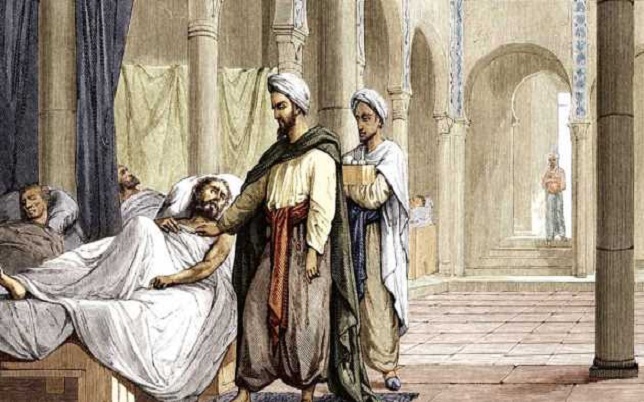
We can obtain an elaborate idea of the good work done by Muslim rulers in India along the lines of public welfare from historical records like Tuzuk-i-Jehangiri and Ain- i-Akbari. They built numerous hospitals, poor-houses, public parks, and gardens, tanks and canals.
Maulana Syed Abdul Hai has furnished, in his unique work, Jannat-ul-Mashriq, a long list of hospitals and other benevolent and public welfare institutions set up and development projects undertaken in India during the so-called Muslim Period.
All the huge highways that connect the western parts of the sub-continent with its eastern parts were given to it by Muslim kings and emperors. The most important of them is the one built by Sher Shah. It is 3,000 miles (or 4,832 Kilometers) long, and runs from Nilab in Sind to Sonargaon (Sonargaon was the capital of East Bengal during the Muslim rule. Now it is known as Painam and forms part of the District of Dhaka) in what is now Bangladesh.
At every second mile of the road there was a caravanserai (resting place for travelers) with separate charitable grub houses for Hindu and Muslim travelers and a mosque. The Muezzin (Public crier to Prayers), Imam (Official priest in a mosque) and Hafiz (One who has learnt the whole Quran by heart) for the mosque were appointed by the State. A pair of speedy horses were stationed at each caravansarai to carry the mail so that letters and messages could be sent regularly from Nilab to the distant borders of Bengal.
Fruit bearing trees were planted on either side of the road whose fruit and shade were a great boon to the travelers. In addition to this, Muslim rulers also achieved great success in the training of animals and the improvement of livestock.
10 Gifts by Muslims to India

The noted historian, Sir Jadunath Sircar, has, in a paper entitled ‘Islam in India’, enumerated ten gifts, which, according to him, the Muslims conferred on India. Some of these we have already discussed in this post; the gifts are as follows:
- The establishment of contact with the outside world
- Concept of divine unity (belief in only one God)
- Concept of equality and brotherhood (no caste system & untouchability)
- Rights of women and other social reforms
- Introduction of new branches of learning in India
- Political unity and uniformity of culture and dress specially in the upper classes
- A common official language and an easy, simple style of prose in the evolution of which both the Hindus and Muslims have taken part
- The promotion of regional languages under the aegis of the Central Government so that there may ensue general peace and contentment and equal opportunities for literary and cultural advancement may be made available to all
- The revival of maritime trade which was originally in the hands of the people of South but had been lying suspended for a long time
- The formation of the Indian navy
Material and Spiritual Achievements of Muslims in India
Speaking of the material and spiritual achievements of Muslims in India, W. W. Hunter, a noted anti-Muslim writer, has observed that
“The Musalmans led several of these great land reclamation colonies to the southward, and have left their names in the Eastern Bengal as the first dividers of the water from the land.
The sportsman comes across their dykes, and metalled roads, and mosques, and tanks, and tombs in the loneliest recesses of the jungle; and wherever they went, they spread their faith, partly by the sword, but chiefly by a bold appeal to the two great instincts of the popular heart.
The Hindus had never admitted the amphibious population of the Delta within the pale of their community.
The Muhammadens offered the plenary’ privileges of Islam to Brahman and outcaste alike.
‘Down on your knees, every one of you,’ preached these fierce missionaries, ‘before the Almighty in whose eyes all men are equal, all created beings as the dust of earth.
Here is no god but the one God, and His Messenger is Muhammad. The battle cry of the warrior became, as soon as the conquest was over, the text of the Divine.”8
8. Hunter, W. W.- The Indian Musalmans (1876), pp. 154-155
Luminous Torch of Islam comes to India
N. S. Mehta, a gifted Indian civil servant, says in course of an article entitled, ‘Islam and the Indian Civilization’:
“Islam had brought to India a luminous torch which rescued humanity from darkness at a time when old civilizations were on the decline and lofty moral ideals had got reduced to empty intellectual concepts.
Similar to other lands, in India too, the conquests of Islam were more widespread in the world of thought than in the world of politics. Today, also, the Islamic World is a spiritual brotherhood which is held together by community of faith in the Oneness of God and human equality.
Unfortunately, the history of Islam in this country remained tied up for centuries with that of government with the result that a veil was cast over its true spirit, and its fruits and blessings were hidden from the popular eye.”9
9. Reproduced from Sabahuddin Abdul Rahman’s “Hindustan Ki Ahd-i-Wusta Ki Ek Jhalak”.
In sum, as it would be evident from the facts we have stated in the foregoing pages and the opinions we have examined that what Muslims gave to India was much greater and far more lasting and valuable than what they took from it.
The coming of Islam and Muslims marked the beginning of a new era in history of India—an era of enlightenment, progress and prosperity—which it can never possibly forget.

